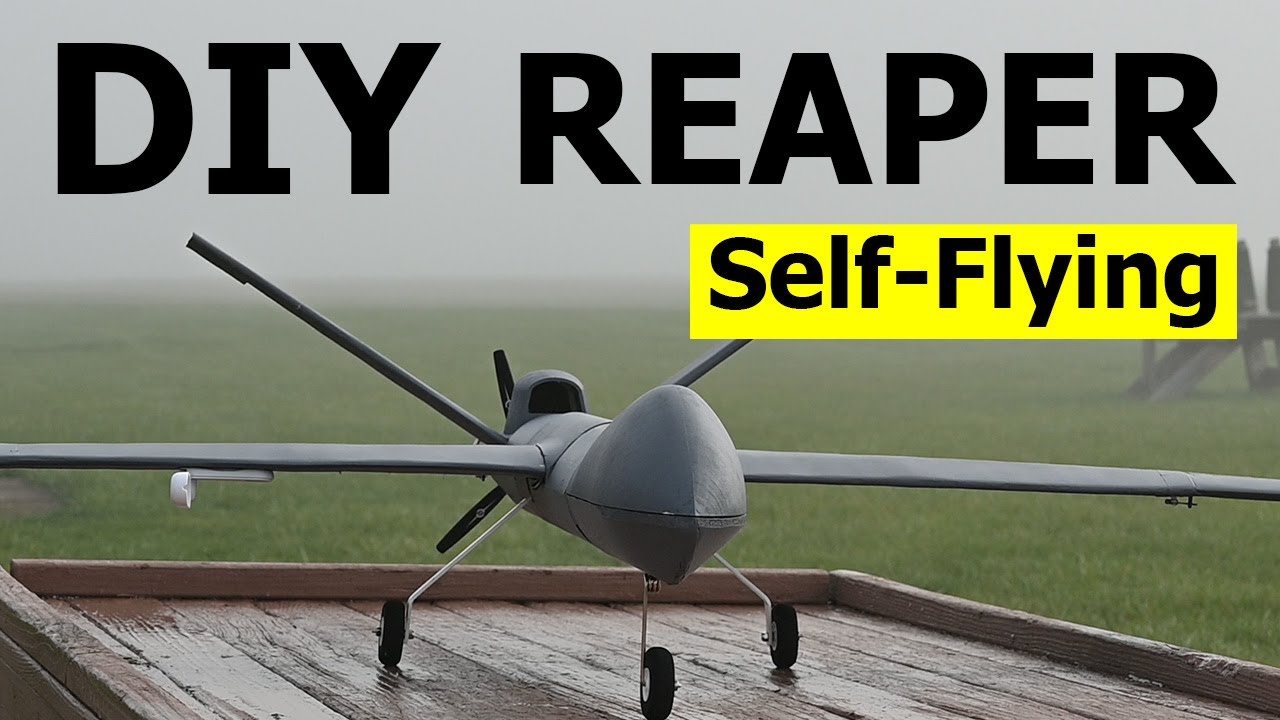Embarking on the adventure of building your very own REAPER drone is a thrilling and educational experience. Imagine crafting a magnificent two-meter wingspan flying machine, primarily from laser-cut wood, foam board, and some clever 3D printed components. It’s not just about putting parts together; it’s an opportunity to dive into the world of laser cutting, experiment with materials like carbon fiber tubes and lightweight PLA, and master the art of putting it all together. Whether you’re powering it with a brushless motor or configuring a Matek 405 flight controller for autonomous flight, each step is a journey in itself.
You will face ups and downs, just like the drone’s flights. The thrill of successful flights comes with the reality of setbacks, like a rough landing and the challenges of balancing weight for longer journeys. But that’s part of the charm, right? Leveraging the insights and suggestions from an engaged community can open doors to even better designs. So, as you craft, test, and learn, remember that every mishap is a stepping stone toward improvement, leading you closer to creating a sturdier, reliable flying partner for your future aerial adventures.

This video is sponsored by PCBWay:
For high-quality and fast PCB & CNC manufacturing, visit: https://www.pcbway.com/
Thanks for watching! Let me know if you should rebuild this project. Any suggestions on more durable methods for building RC planes?
Patreon: /michaelrechtin
CAD File: https://cad.onshape.com/documents/da0…
Follow for more project updates:
Instagram: www.instagram.com/michaelrechtinyt/
Twitter: /rechtin_michael
Links to equipment I use (affiliate links):
AnyCubic Kobra Go: https://bit.ly/3quyQnL
Creality CR-10S: https://amzn.to/3BuAiM2
Ender 3 S1 Plus: https://amzn.to/3xv7zW8
Elegoo Mars 3: https://amzn.to/3UwVvh1
Creality LD002H: https://amzn.to/3QXhpqJ
Creality Wash Station: https://amzn.to/3S1NTBi
Materials and Tools Required
When embarking on a DIY project like building a REAPER drone, having the right materials and tools is crucial. Here’s what you’ll need:
Laser-cut wood
Laser-cut wood is a foundational material for the drone’s frame. It’s lightweight, yet sturdy, providing the necessary structure without adding excessive weight. Quarter-inch plywood is commonly used, although balsa wood is a preferable alternative for reducing weight further.
Foam board
Foam board is another essential component, especially beneficial for creating aerodynamic surfaces like wings and fuselage. It’s praised for its lightness and ease of cutting, accommodating intricate designs with precision.
3D-printed parts
For components requiring complex shapes and precision, 3D-printed parts come into play. Lightweight PLA is ideal here as it reduces weight while maintaining strength. This material is particularly useful for creating detail-oriented sections such as the control surfaces and hinges.
Carbon fiber tubes
Carbon fiber tubes serve as the backbone for reinforcing the wings and connecting them to the fuselage. Their high strength-to-weight ratio ensures stability and durability, critical for ensuring that the wings remain securely attached during flight.
Lightweight PLA
As mentioned, lightweight PLA is utilized for 3D printing vital drone components. This material is chosen to optimally balance strength and weight, allowing the drone to function efficiently without unnecessary mass.
Quarter-inch plywood
Quarter-inch plywood is cut into pieces forming the frame of the drone. It’s affordable and, while not as lightweight as balsa wood, it’s more accessible and easy to work with for structural elements.
Fiber-reinforced tape
Fiber-reinforced tape aids in reinforcing the seams and trailing edges of the wings. Though it may not be the prettiest addition, it enhances durability, helping the wings withstand air pressure during flight.
Additional tools and supplies
A hot glue gun, exacto knife, and various adhesives are indispensable for assembling different parts of the drone. Basic electronic tools are also required for motor and flight control system installations.
Designing for Laser Cutting
Understanding and mastering the design for laser cutting offers substantial benefits, particularly for a project that requires precision and detail like a drone.
Understanding the basics of laser cutting
Laser cutting involves using a laser to slice materials with high precision. The technology utilizes a CAD file to direct the laser beam for cutting intricate patterns. The process is quick, accurate, and suits materials like woods and foams well.
Design techniques specific to drones
Designing for drones requires special consideration of aerodynamics and weight distribution. By minimizing material use while maximizing structural integrity through strategic cuts, you can enhance the drone’s performance and stability during flight.
Software recommendations
Software such as AutoCAD or Fusion 360 is recommended for crafting your designs. These programs allow you to create detailed 2D and 3D models of the drone components, ensuring precision when laser cutting.
Tips for effective cutting
Ensure the laser settings are optimized for the material you’re using. Practice on test pieces to avoid costly mistakes, and always ensure your designs are compatible with your laser cutting equipment’s capabilities.
Building the Drone’s Wings
Crafting sturdy and aerodynamic wings is crucial for any drone project.
Cutting and assembling the wing frame
Start by laser cutting the frame’s pieces from quarter-inch plywood. This frame acts as the skeleton for the wings, and its assembly is quite like a jigsaw puzzle. Once assembled, it offers a rigid foundation on which other materials can be layered.
Applying foam board for aerodynamics
Cover the wooden frame with foam board meticulously cut to fit. This layer isn’t just about aerodynamics; it provides an aerodynamic shape that significantly enhances lift and reduces drag, critical for stable flight.
Reinforcing wings with fiber-reinforced tape
Apply fiber-reinforced tape along seams and edges. This tape enhances the strength of the wings’ joints, prolonging their lifespan even under the stress of multiple flights.
Constructing the Fuselage
The fuselage acts as the main body of the drone and needs to be both lightweight and strong.
Foam board assembly using hot glue
Cut foam board into the various pieces that make up the fuselage. Use hot glue to join these pieces, forming a robust but lightweight main body. This method allows for easy adjustments during assembly.
Integrating complex 3D printed features
For intricate parts of the fuselage that require precision, use 3D-printed components made from lightweight PLA. These parts seamlessly integrate into the foam assembly, providing additional functionality and strength.
Ensuring structural integrity and balance
It’s critical to consistently check the balance and structural integrity as you build. A well-balanced fuselage enhances the drone’s handling and flight stability.
Motor and Propeller Setup
The motor and propeller choice drastically affect the drone’s power and efficiency.
Choosing the brushless motor
Select a brushless motor that, while perhaps overpowered, can provide sufficient thrust. A spare motor from previous projects can often fulfill this need, saving costs and promoting sustainability.
Installing the 9-inch three-blade propeller
A 9-inch three-blade propeller should be attached to the motor. It offers ample thrust and contributes to smoother flight dynamics, improving overall performance.
Balancing power and efficiency
Ensure the motor-propeller combination is aligned with your power needs. Excess power can lead to inefficiencies, while too little can impede performance and flight time.
Flight Control Systems
Efficient control systems are vital for autonomous and manual operations.
Overview of the Matek 405 flight controller
The Matek 405 flight controller, running ArduPilot (ArduPlane), is the brain of your drone. It processes inputs from the pilot and various onboard sensors, executing commands that keep the drone flying smoothly.
Installing RC receiver and telemetry radio
Install the RC receiver to enable remote command inputs. Coupled with a telemetry radio, it allows for real-time data communication between the drone and your control setup, enhancing control precision.
Integrating GPS for navigation
A GPS system is fundamental for autonomous flights. Integrated into the flight controller, it allows for programmed navigation, ensuring the drone maintains course and altitude automatically.
Sponsored Insight: PCBWay Contributions
PCBWay plays an unexpected but crucial role in this project and other electronics-based projects.
Role of PCBs in drone functionality
PCBs are pivotal in interlinking the electronic components. They manage the connections for systems like the flight controller, enabling high performance and reliability.
PCBWay manufacturing services
PCBWay offers affordable manufacturing services for high-quality PCBs, easing the burden of creating custom electronic circuits critical for projects like drones.
Benefits of custom PCBs
Custom PCBs streamline your electronics, reducing weight and space requirements. This optimization can lead to enhanced drone performance, an ideal benefit when innovation is the goal.
First Flight and Challenges
The initial flight testing phase is where plans are put to the test, and challenges often surface.
Initial takeoff issues due to terrain
The first takeoff was marred by terrain challenges, with high grass interfering with the takeoff roll, necessitating a manual launch.
Successful hand launch and in-flight stability
Despite the rocky start, a hand launch got the drone airborne. It showcased commendable stability and control, flying gracefully against the backdrop of clear skies.
Landing gear damage and immediate fixes
Landing was less than perfect, causing damage to the landing gear. Quick fixes were applied using tape, a simple yet effective method to resolve such minor breakages.
Attempts at Feature Testing
Once basic flight is proven, further testing involves advanced features.
Exploring autonomous capabilities
Autonomous capabilities were trialed, leveraging ArduPilot’s features such as loiter mode, successfully keeping the drone circling a point while maintaining altitude.
Effects of larger batteries on flight
Testing revealed the challenge larger batteries pose: improved flight time but considerable extra weight. This necessitated a delicate balancing act to optimize flight dynamics.
Analyzing crash and damages
A heavier setup led to an unfortunate crash during subsequent tests. The crash highlighted areas needing improvement, such as weight distribution and the need for more resilient materials.
Conclusion
Summary of the project
Building a DIY REAPER drone provided a multifaceted learning experience, from design and assembly to flight tests and modifications. Despite challenges like crashes, the project demonstrated the potential and intricacies of drone construction.
Acknowledgments to viewers and sponsors
Special thanks go to PCBWay for their sponsorship and support, as well as to viewers who followed the project’s journey, providing invaluable insights and encouragement.
Encouragement for innovation and experimentation in DIY projects
Innovation thrives in the world of DIY projects. Whether tackling drones or other fields, the spirit of experimentation and creativity drives progress. Encouragement goes out to all enthusiasts to keep pushing boundaries, exploring new technologies, and transforming ideas into reality.
